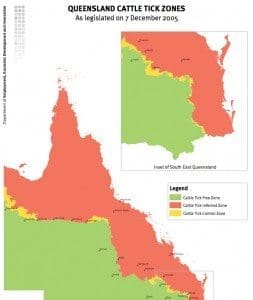
The yellow areas denote the existing cattle tick control zone. Click on map to view in larger format
The Queensland Government is pushing ahead with plans to remove the cattle tick control zone or ‘buffer zone’ in favour of having just two biosecurity zones – an infected zone and a tick-free zone.
After consulting with industry, the State’s Department of Agriculture reports that the general consensus from stakeholders is that moving from three zones to two is preferable to reduce red tape and confusion.
Cattle ticks cause the greatest economic impact of any disease or parasite to the Australian beef cattle industry, according to a June 2015 MLA study, with producers in Queensland bearing the brunt of the estimated annual cost of $160 million.
In a media release issued on Monday, Minister for Agriculture and Fisheries Bill Byrne said his Department will now commence work to draft new regulations under the Biosecurity Act 2014 to move to a new cattle tick control and management system in Queensland.
Biosecurity Queensland Director Ashely Bunce said broader community consultation would commence shortly to seek input particularly from producers who live along the tickline and will be most affected by any changes to cattle tick regulations.
“During consultation on the Queensland Biosecurity Regulation – Regulatory Impact Statement last year, three options for cattle tick management were put forward,” Mr Bunce said.
“The preferred cattle tick management strategy, Option 2, is to create two biosecurity zones, infected and free, with movement restrictions on host species travelling from the infested area to the free area.”
Minister Byrne said the Queensland Government is determined to see “an end to the confusing cattle tick control zone”.
Part of Queensland will be a cattle tick free zone and the remainder will be an infected area.
“In determining the location of the tickline, consideration will be given to the sustainability and integrity of the free zone and the costs and impacts on both industry and government,” he said.
“Every effort will be made to locate the tickline in the most sustainable or defendable position utilising buffers including environmental, natural or man-made features that will impede cattle tick infestations or propagation of ticks when they do occur.
“Consultation with the broader community will commence in late October 2015 and will look at key issues such as the location of the tickline, requirements for crossing the tickline with livestock and management of cattle tick infestations in the free zone.”
Source: Queensland Minister for Agriculture. For more information on cattle tick control in Queensland visit www.biosecurity.qld.gov.au or contact Biosecurity Queensland on 13 25 23.
RELATED ARTICLE: Rethinking tick control – start with the paddock


